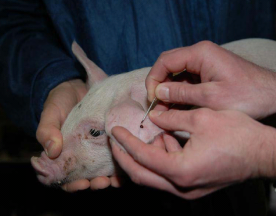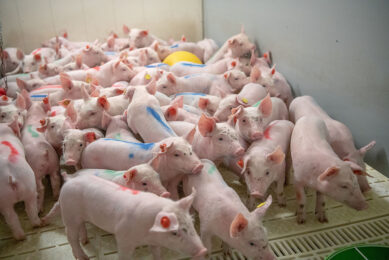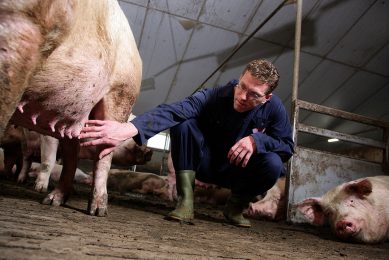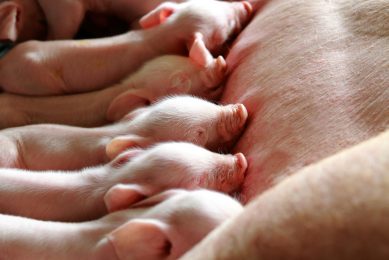Iron for piglets: injection or oral?

Piglets need iron supplements as they have a low deposit at birth, have a high grow rate and normally not have the ability to get the iron from soil. Sow milk only covers 10% of the iron need: this comes down to an iron deficit of approximately 155 mg per piglet. An iron injection is the most common method of filling this gap, but oral supplementation is a good alternative with some positive side effects.
By Emmy Koeleman
The iron (Fe) may be given as an injection or be based on voluntary consumption. While early conventional iron injection is a safe way of securing sufficient iron to all the suckling piglets, there is some evidence that early iron injection as opposed to voluntary oral Fe intake may increase the risk of joint infections and generalized infectious diseases in the piglets.
A study by Holmgren from 1996 revealed that about 10 percent of the piglets get polyarthritis if injected with iron on the first day of life. If piglets were first injected with iron in their fifth day of life, the incidence of polyarthritis was significantly reduced (p <0.01), and if they instead of iron injection received iron orally via an iron-enriched rooting material, the incidence of polyarthritis was further reduced (p <0.001). A similar study by Rantzer et al presented at IPVS this summer showed a similar picture with regard to arthritis and iron injection. An early injection (day 1-4) leads to more polyathritis (17.5 pecent) A later injection reduced the prevalence of joint infection, but the growth was reduced. With oral iron the polyarthritis incidence was low and growth was high.
Iron regulation
Of course we don’t want more joint problems in piglets, but just want them to be strong and healthy with the extra iron shot. According to some experts, oral iron powder is a better alternative to the needle because it mimics the natural iron uptake and regulates natural regulatory iron mechanisms in the intestines. This means that it helps the piglet in fighting diseases. When a piglet gets infected with a pathogen, different mechanisms are triggered in the body: an immune response, fever but also the iron uptake is regulated. The iron balance plays an important role in fighting pathogens. Bacteria need iron to grow and hepcidin – a small peptide synthesized in the liver – makes iron unavailable for this bacterial growth by blocking the iron transporter in the intestinal cell (ferroportin). Ferroportin is also inhibited by hepcidin when iron levels in the body are sufficient.
What is better?
Both iron injection as oral administration work in terms of getting the iron in the piglet, but which administration method is better or more efficient? With injection you know for sure that the piglet received a certain dosage. Oral supplementation depends on the amount of food or water the piglet consumes – or does not consume – and therefore carries a risk of the piglet receiving either too little or too much iron. However, the same can happen with injection, small piglets receive too much iron, and the big piglets too little. Too much iron in turn can increase the risk of bacterial infection (e.g. polyarthritis in young piglets) according to some studies. On the other hand, dietary iron uptake is regulated in the duodenum, triggered by oral administration of iron. Injected iron cannot be regulated this way. In terms of animal welfare, the oral supplementation wins, less injections is less pain and stress in the piglets. It also seems the most natural way of getting the iron to the piglet. In terms of the differences in efficiency, costs and labour between both ways of iron supplementation I am not aware of any studies done in this field. Maybe some readers have experiences with this?
On the picture: Haemoglobin levels are tested for iron anaemia. It is generally accepted that Haemoglobin levels in piglets should be above 80-90 g/1000 ml blood.











